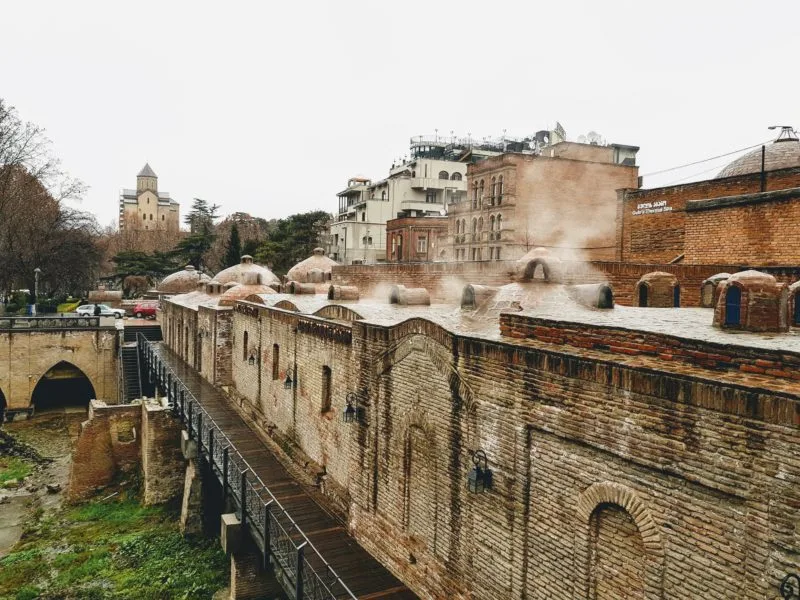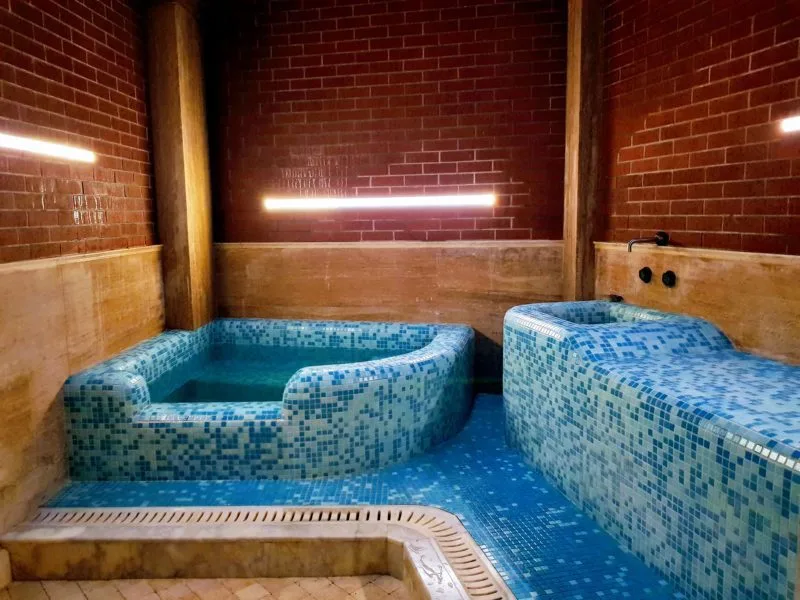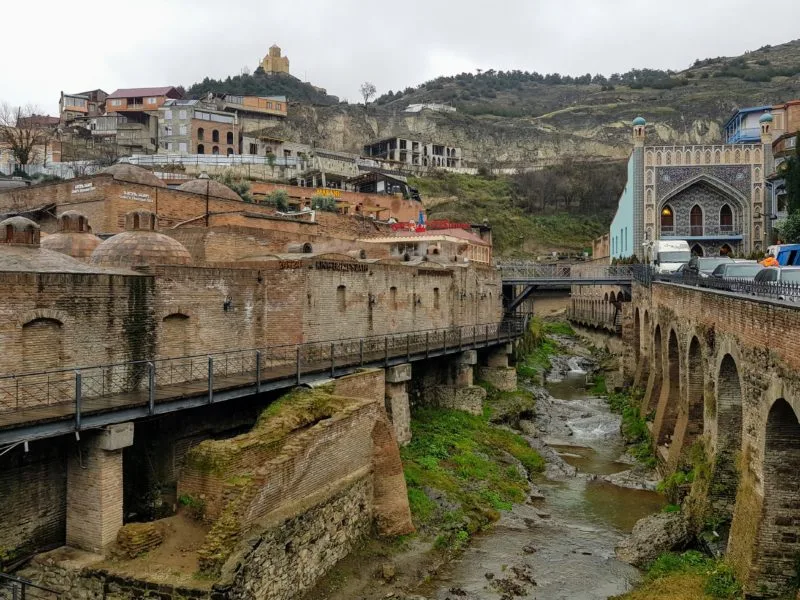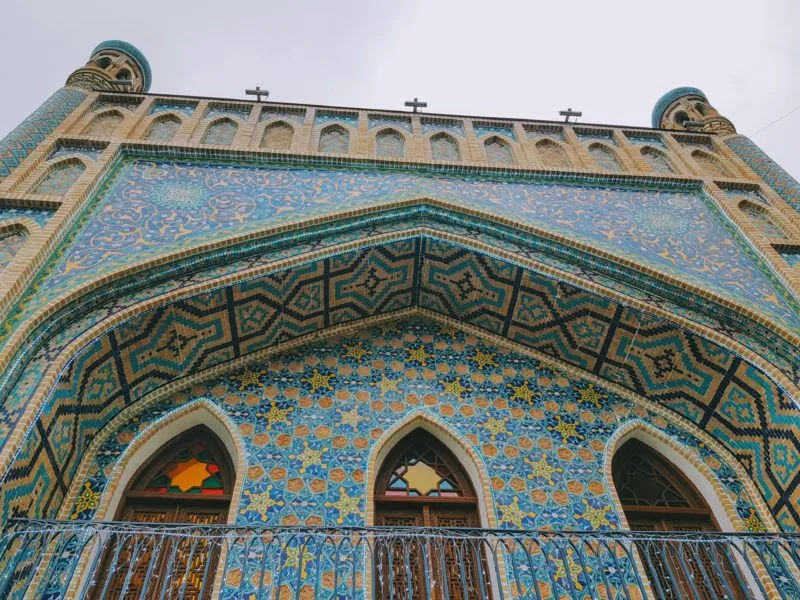Last updated: 25 June 2023
When we told a few people we were heading to Georgia they said that a visit to the Tbilisi sulphur baths is one of the must do activities in the Georgian capital. Tbilisi’s location on the Old Silk Road and the healing properties of the sulphur water, said to help in the treatment of eczema, arthritic pain and digestive problems, made it popular recreation for locals and merchants passing through between Asia and Europe.
Throughout our travels we’ve soaked in hot tubs in Majorca, we’ve bathed with locals in the ornate Szechenyi baths in Budapest, and steeped in the outdoor thermal pools of southern Iceland in the depth of winter. Experiencing the culture of Tbilisi’s sulphur baths seemed like a unique relaxing experience great opportunity and one not to miss.
[lwptoc]
The History Of The Sulphur Baths In Tbilisi
The city of Tbilisi is built on hot water. The name is derived from the Old Georgian word ‘Tbili’ means ‘warm’.
Legend has it the city was founded by King Vakhtang Gorgasali, the King of Iberia, after he went hunting nearby in the heavily wooded region with a falcon. It’s said that the King’s falcon caught a pheasant after which both birds fell into a nearby hot spring and died.
Impressed by the warm waters and the potential healing of the hot sulphur springs the King built the capital here and named it Tbilisi.
Fed by underground bubbling sulphur springs, Tbilisi’s bath district is located in Abanotubani, a district situated under the imposing hilltop Narikala Fortress on the southside of Mtkvari River which divides Tbilisi. Accessible on foot from most hotels, our hotel was near Liberty Square and just a 10 min walk to Abanotubani.
Finding the bathhouses is easy, simply follow your nose. The prickly tingly rotten egg odour which emanates from the hot sulphur springs is one that is pretty easy to pinpoint. Similarly, the rows of red brick bathhouses with their crown of cupolas visually identify the subterranean bathhouses below.
Choosing A Bathhouse In Tbilisi
Once you’re in Abanotubani, there are currently five bathhouses to choose from. We managed to make it to Orbeliani Baths, but received local recommendations for another two (Bathhouse No. 5 and Gulo’s Baths).

Details vary from one bathhouse to another so it’s best to check the offering in advance. Some bathhouses offer either public communal baths or private baths. Some bathhouses offer both. Public baths are divided by gender and nudity is common. The pluses for public baths are that you’re likely to get a more local authentic experience and the added bonus that they’re cheaper and typically no time limit. Depending on the experience you’re seeking, the downside is there’s a whole lot of public nudity involved. Private rooms, which vary in size, are aimed at tourists with additional services add-ons and are priced higher than communal baths.
My Experience Visiting Orbeliani Baths
We chose the stunningly ornate with blue-tiled facade Orbeliani Baths for our Tbilisi sulphur baths experience. It is easily the prettiest facade of all the bathhouses in Tbilisi and was popular with famous people of the past, the most noteworthy guest was Russian poet Alexander Pushkin in 1829 and French author Alexandre Dumas.
Sulphur Baths in Tbilisi, How Much Do They Cost?
A private room consists of a hot sulphur pool, resting area, ensuite including toilet and shower and a stone massage table. For this you should expect to pay around 60-80₾ (Lari) per hour. Our room at was slightly larger for up to 3 people and charged at 70₾ ($26 USD, £20 GBP).
The cheapest option (good for solo travelers or a couple) at Orbeliani Baths is for a private room including sulphuric water bath, private shower, toilet and resting area starting at 50₾. ($19 USD, £15 GBP).
For a large room able to accommodate up to 6 people includes all of the above plus another pool for 150₾ ($56 USD, £44 GBP). Larger groups can make use of the VIP and King rooms which have more space and features, with a price range between 300₾ to 500₾ per room.
It’s a good idea to remember that these private room rates are charged per room per hour (not per person) so if you go as a couple or a group it becomes much cheaper.

At Orbeliani Baths, additional charges apply for towels, disposable slippers, soap and drinks. While these additions are very affordable, you can bring your own if you’re wanting to save some money.
Read More: Street Art in Tbilisi
Scrub and traditional massage services are common add-ons. So I opted for a scrub massage for 20₾ ($7.50 USD, £6 GBP) paid direct to the masseuse even though I wasn’t entirely sure what this entailed but I was determined to give it a go anyway.
Overall cost for our sulphur bath was for two adults in a private room, in-room massage, towels and slippers for an hour: 100₾ ($37 USD, £29 GBP)
What Really Happens Inside A Bathhouse?
There’s no mystery or secret handshakes needed to enter, nor are the bathhouses in Tbilisi shady nor dodgy. The industry is entirely professional and single female travellers should not hesitate embracing a local custom such as the sulphur baths.
We had a local call to reserve our room, (some bathhouses you can book via Facebook) for a dedicated time and arrived 10 mins early to ensure we got the most from our booking. The room (#10) was ready on our arrival so we were shown to the room straight away, provided with large clean towels and disposable slippers (similar to those you’d find in an upmarket hotel).
The first thing you should know is that private rooms are fitted with locks so you’re welcome to bathe naked or in swimwear if you’re more comfortable. The room is yours for the duration of your booking and aside from a masseuse (if you book one) no one will bother you. Similarly, rooms are equipped with a clock and a phone to call reception if you have any questions or need something brought to you.

The social convention is to shower thoroughly prior to bathing so that’s what we did before sinking ourselves into the tiled sulphur pool. As we submerged into the sulphur pool a displaced wave of water overflowed onto the floor. Flooding the tiled section right up to the edge. I was surprised by the volume of water but apparently this is normal. With this in mind, hang everything! Including your shoes, up high just to be sure everything stays dry.
There isn’t much to keep you entertained inside the bath. For local Georgians, communal bathing has long been a place to catch up on local gossip, events and bond with your family and friends. The private rooms don’t much allow for such things. You can certainly bring a book, listen to a guided meditation, or chat to your bathing partner(s), aside from that you can expect to be alone with your thoughts for the duration of your soak.
What Really Happens during a Sulphur Baths Scrub Massage?
I had so much to say about this that I wrote an entire post about my massage experience. I cover everything from the black lacy bra she wore to the coarse exfoliating mitt that saw the intricacies of my body.
Get The Full Story
What Do You Need To Bring To The Tbilisi Sulphur Baths?
I like to be prepared so I took an array of contingency items in case I needed them. The private room was sight unseen so I took modest swimwear, thongs, shampoo and conditioner, and a small compact travel towel.
How much of it did I use? None of it! I kept my hair mostly dry and didn’t feel the need to wash it under the sulphur shower, besides there was no hairdryer in the room to dry it anyway. If need be, I thought I could always wash it back at the hotel later.

If you don’t want to bathe naked then you’ll need to pack swimwear. If you choose to BYO towels, slippers/thongs, soap, drinks you will save yourself some Lari but you have to ask yourself if it’s worth the hassle of carrying wet items in your bag all day. I think not.
We took our GoPro in a waterproof housing and water resistant mobile phones with us, the lock on the door meant that even if we didn’t want these items in the sulphur bath we could leave them in the resting area which was within sight and secure. If you’re unsure of the storage arrangements at your chosen bathhouse, it would be pertinent to take a small padlock.
Cameras are permitted in private rooms but not in public ones.
The Verdict
The room and pool was clean, along with decent sized fresh towels and new disposable slippers. Reception staff spoke English and were able to answer questions as well as showing examples of the different types of rooms on monitors at reception.
When comparing this experience to that of a Moroccan hammam, or a western style scrub, it is slightly more rudimentary. The massage service is functional and effective. I needed to surrender to the experience and go with the flow. While I initially doubted that an hour in the sulphur pool would be enough, it was more than sufficient.
Overall, I left feeling warm, rejuvenated, and relaxed. My skin is new-born smooth and softer than ever.
Would I do it again?
Yes, yes I would. Now that I have an idea of what happens at a sulphur bath in Tbilisi, if I was travelling to Georgia again I might even be tempted to try the communal bathing, providing I don’t run into anyone I know!




[…] you visit Tbilisi one of the activities that you should do is enjoy a Sulphur bath. They are situated in the Abanotubani region which is one of Georgia’s most ancient districts. […]
[…] best to check in advance and get some advice before you choose a bathhouse as they can be slightly different and booking may be required. Nudity […]
Great story, Roma. Heading to Tbilisi soon, so thanks for sharing it.
Great news Filipe! You’re going to have a great time in Tbilisi. Do pop back to the blog, we’ve got more Georgian content on the way! 🙂